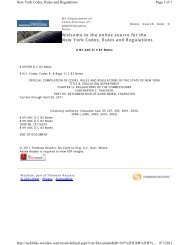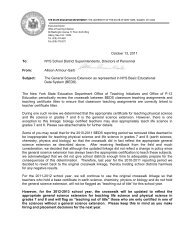ESL Learning Standards - Higher Ed - New York State Education ...
ESL Learning Standards - Higher Ed - New York State Education ...
ESL Learning Standards - Higher Ed - New York State Education ...
You also want an ePaper? Increase the reach of your titles
YUMPU automatically turns print PDFs into web optimized ePapers that Google loves.
Standard 1: Continued<br />
Elementary Grade Sample Classroom Tasks:<br />
English Proficiency Level<br />
Beginning<br />
Students listen to or read a simple book about bats (e.g.,<br />
Screech! by Melvin and Gilda Berger, Amazing Bats by<br />
Frank Greenaway, Bats by Gail Gibbons, or Zipping,<br />
Zapping, Zooming Bats by Ann Earle). Teacher displays<br />
four sheets of poster paper, each bearing one of the following<br />
titles: What Bats Eat, What Bats Do, What Bats Look<br />
Like, Where Bats Live. Students look at a variety of picture<br />
books and draw and label (with teacher’s help) interesting<br />
facts. Class collaborates to categorize information (i.e.,<br />
attach it to the appropriate poster). Students create their<br />
own illustrated bat books, using a template provided by the<br />
teacher.<br />
Performance indicators: 1, 2, 4, 7, 15, 16<br />
Intermediate<br />
Teacher shows pictures of bats. Class creates a KWL chart<br />
reflecting students’ prior knowledge and their questions<br />
about the topic. Teacher makes available a variety of picture<br />
books on bats (see Beginning task). While students<br />
look through the books and discuss interesting finds with<br />
each other, teacher writes down comments verbatim.<br />
Teacher helps students share all their interesting facts and<br />
observations with the class as they enter them on poster<br />
paper, as described in Beginning task. Teacher and class<br />
read Stellaluna by Janell Cannon (identifying factual vs. fictional<br />
elements) or sing B-b-b-bats! by Norma Gentner<br />
(Wright Group Publishing. Co.). Students continue to add<br />
to posters. Students make their own illustrated books<br />
about bats by selecting and paraphrasing a variety of categorized<br />
information.<br />
Performance indicators: 1, 2, 3, 4, 6, 7, 15, 16<br />
<strong>ESL</strong><br />
1<br />
Elem<br />
Teacher brings in photographs of different life events (e.g.,<br />
as a baby, on the first day of school, at graduation). Class<br />
brainstorms important events in students’ lives. Students<br />
take home simple questions to gather information about<br />
events from family. They share information with class,<br />
including photographs, if possible. Teacher demonstrates<br />
the creation of a personal timeline using brief captions.<br />
Students order their photographs chronologically and create<br />
their timelines with teacher’s help. Students share timelines<br />
and discuss similarities and differences. Timelines and<br />
photographs are displayed on bulletin board.<br />
Performance indicators: 2, 3, 4, 5, 7, 9, 14<br />
Students complete Beginning task, using more detailed<br />
information for the timelines. Students use the timelines to<br />
write simple autobiographies, which may be shared in<br />
class. Students listen to or read an illustrated biography of<br />
a historical figure such as Harriet Tubman (e.g., Go Free or<br />
Die by Jeri Ferris, Escape North! by Monica Kulling, Minty:<br />
A Story of Young Harriet Tubman by Alan Schroeder).<br />
With teacher’s help, class creates a timeline of Tubman’s<br />
life. Small groups collaborate to create parts of a matching<br />
game of questions and answers about Tubman’s life, to be<br />
played by the class.<br />
Performance indicators: 1, 2, 3, 4, 5, 7, 8, 9, 10, 12, 13, 14,<br />
16<br />
Students listen to or read Pizza by Saturnino Romay<br />
(Scholastic). Students pantomime the steps in pizza making<br />
(e.g., measuring, chopping, kneading, sprinkling), making<br />
sure steps are in correct sequence. Teacher creates word<br />
wall for vocabulary, including sequence words. Students<br />
write and draw simple steps in order. Class collaborates to<br />
make a real pizza, following the steps outlined.<br />
Performance indicators: 1, 7, 9, 12, 13<br />
Students read Banana Shake. Small groups list the steps<br />
involved in making a banana shake, using sequence words.<br />
Students take turns carrying out the steps to make a real<br />
banana shake, while the teacher (or a student) takes a (digital)<br />
photograph of each step. Class collaborates in the creation<br />
of their own “Banana Shake” book, (modeled after<br />
Banana Shake by P. Cartwright) using photographs and<br />
captions. Students do a presentation and demo in another<br />
classroom and share banana shake.<br />
Performance indicators: 1, 3, 7, 9, 12, 13<br />
44 <strong>Learning</strong> <strong>Standards</strong> for <strong>ESL</strong>
















